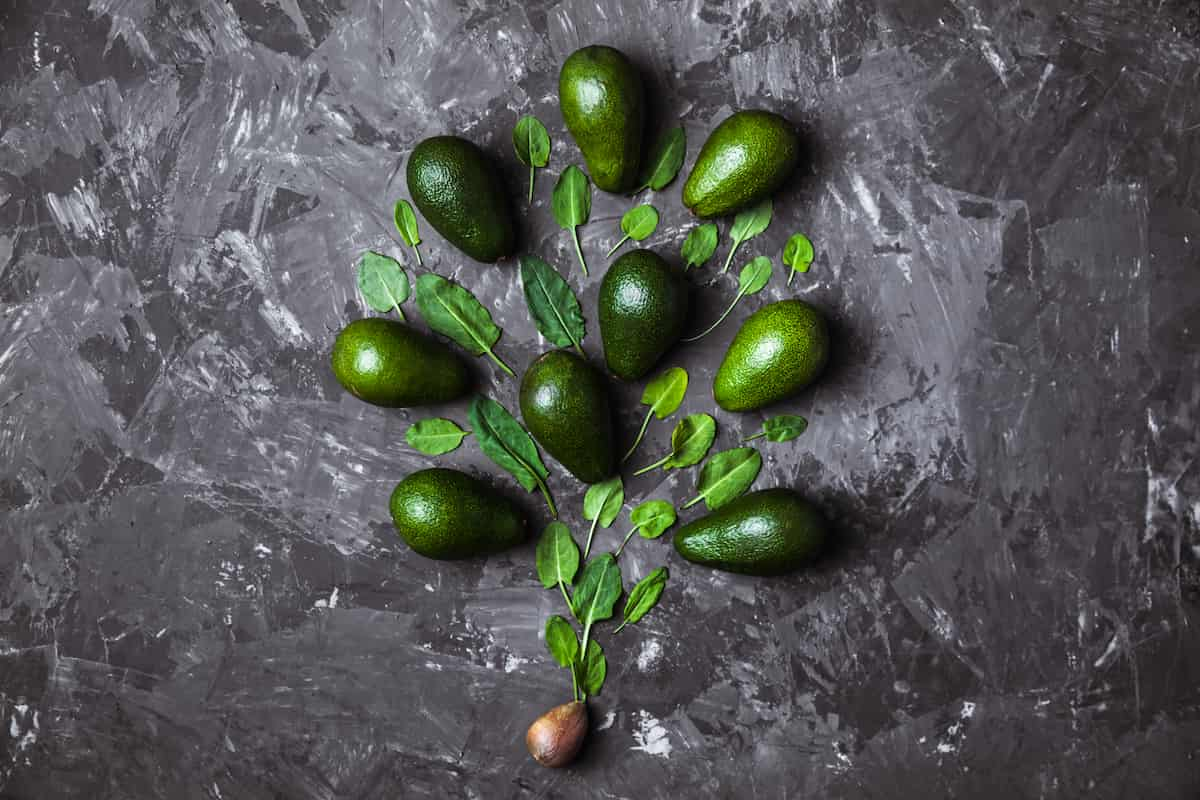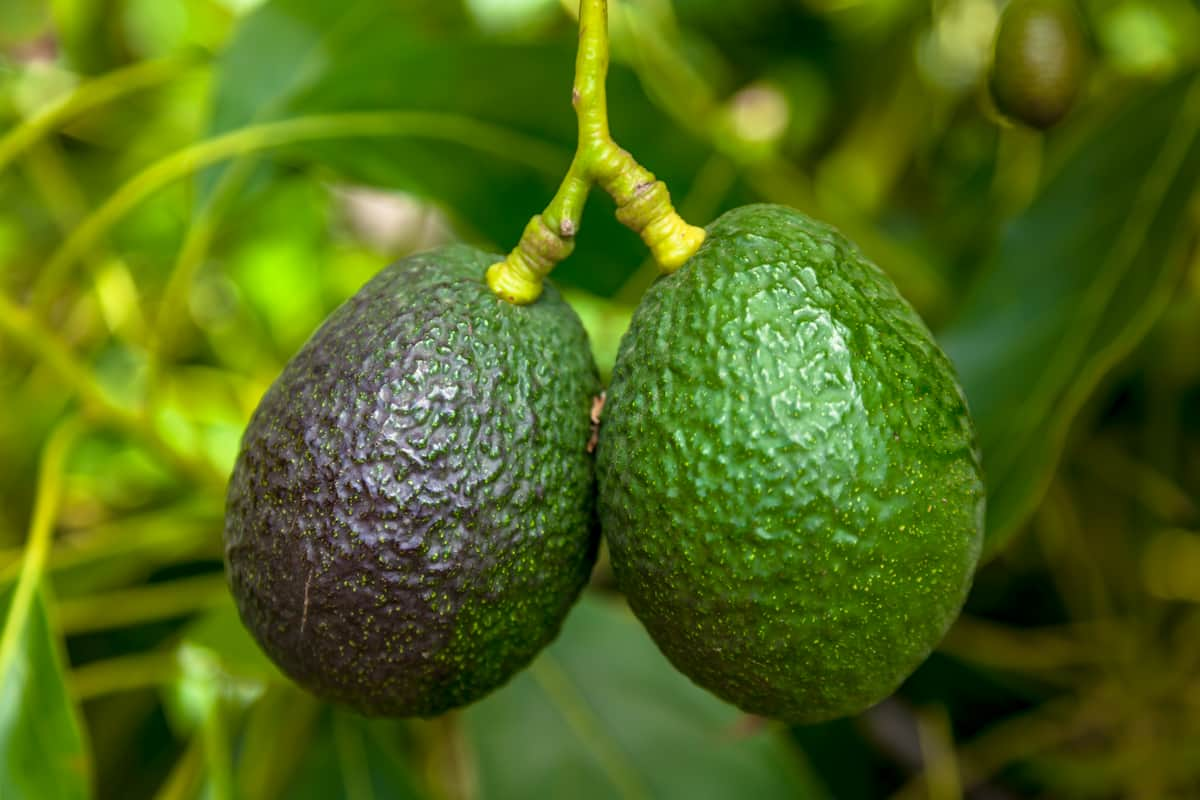The avocado plant grows in tropical regions (native to southern Mexico), so if you live in USDA Zones 10-12 (no frost), you can also plant avocado trees outside. Soil with rich, well-drained organic matter, full sunlight, and medium humidity is ideal for them. The best time to plant them is between March and June.

If you are growing multiple trees, give them plenty of space since they can grow as tall as 40 feet and as wide as 20 feet. Also, avocado trees have shallow roots that grow mainly in the top 6 inches of soil. Therefore, mulching (choose a coarse option) is important after planting.
How to Grow Avocado Organically
Varieties in Avocado Trees
Fuerte, Bacon, Zutano, Hass, Booth 7, Booth 8, Sharwil, and Ettinger are promising. The varieties Pollock, Waldin, Nabal, Linda, Puebla, Gottfreid, Collins, Booth 8, and Fuerte are recommended for commercial cultivation. The varieties cultivated in India go by several names, such as Purple, Green, Fuerte, Pollock, Peradeniya Purple Hybrid, Trapp, Round, and Long. Among the several existing varieties, perhaps Fuerte is the most widely grown, but it is regarded as unsuitable for the tropics.
Cultural Requirements
For successful fruit production, the trees should be grown in the ground with well-drained soil in sunny, wind-free locations. Do not plant a new avocado tree in a space where an old tree died, as there may be a disease in the soil. If you have heavy clay soil, try planting your avocado tree in a 12–18 inches tall raised bed. Most trees will grow to a full size of 25 feet +; therefore, site selection is very important.
Propagating an Avocado Seedling from Seed
- The pit of an avocado can be saved (without cutting into or breaking it) and washed off of any residue. After the pit has dried, insert three to four toothpicks halfway up the side.
- The pit’s broad end should be held down in a drinking glass or jar. You should submerge the bottom third of the seed in water when putting the container.
- The glass should be placed in a warm spot and away from direct sunlight. It should be changed regularly. Approximately 2-6 weeks will be needed for roots and sprouts to appear. You can try another seed if it does not work.
- You can encourage more root growth by cutting the sprout back to about 3 inches after it reaches a height of about 6 inches.
- Plant the pit in a 10-inch pot filled with rich soil once the stem grows again. Your avocado tree is ready to grow now.
In case you missed it: How to Start a Guar Gum Manufacturing in India: A Profitable Agriculture Business

Planting & Growing Organically an Avocado Tree
Avocados have a very sensitive root system, and all care should be taken when removing the plant from the pot. The planting hole should be three times the width of the root system and have the same depth. The trees should be well-spaced to allow free circulation of air. The spacing should range from 6 m X 7 m to 8 m X 10 m, with an acre occupying 50 to 75 trees.
If your soil is heavy clay, amend the soil with compost, and you can plant in a raised bed at least 12 inches tall by 6 feet wide. Plant no deeper than the soil level in the pot. Do not mound up soil around the trunk of the tree. Cut the pot on opposite sides to peel the container back from the root and soil mass. Do not disturb the roots in any way.
Water Requirements for Avocado Growing
In containers, avocados need consistent and frequent watering. Avocados in the ground prefer infrequent, deep-root watering. Water the plant 2-3 times per week by soaking the soil thoroughly and then letting it dry before watering again. Do not overhead water your avocados. It is best to allow trees to dry out somewhat before you apply water again.
This can help prevent root rot. For determining when your tree needs water, a soil moisture meter can be helpful. During spring and fall, apply a 3–4 inch layer of mulch under the tree’s canopy to help retain soil moisture. Mulch should be kept away from the tree’s trunk by at least six inches.
Fertilize Organically to Avocado Trees
During the growing season, fertilizing an avocado tree will encourage healthy growth and fruit production. Start feeding in late winter to early spring and continue until fall, according to the instructions on the fertilizer label. This tree needs a lot of nitrogen, so make sure the fertilizer you choose contains a lot of nitrogen.
Avocado trees should be fertilized regularly. Fertilize using well-balanced citrus or avocado food. You can also use composted manure, blood meal, fish emulsion, alfalfa meal, or worm castings. Do not disturb the roots when adding fertilizers. Avocado trees that have been fertilized year-round are more cold-tolerant.
Pruning in Avocado Trees
Avocados can be maintained to any size with pinching and pruning. Frequent pinching of young trees is a good method to shape the tree rather than heavy pruning. Prune to shape and control size on larger trees. Avocado trees can be susceptible to sunburn on the trunks of newly pruned trees so you can whitewash with interior white latex paint, diluted 50-50 with water, during high summer heat and intense sunshine.
Organic Pest Control in Avocado Trees
Biological pest control practices reduce the consumption of chemicals by humans. Growing Hass avocados organically, they are prone to mosquitos and whiteflies. Introducing praying mantis can help minimize the mosquito population on the farm. Since they feed in the morning, late afternoon, and night, they can damage many fruits. Proper sanitation on the farm should be observed. All fallen fruits should be removed since they provide a breeding ground for whiteflies. Alternative hosts, such as guavas, should not be planted close to avocado plants.
In case you missed it: How to Start a Fruits and Vegetables Export in India: A Profitable Agriculture Business

Overwintering Avocado Trees
As long as avocado trees are grown in the right zones, they do not require extra care during the winter unless there is a frost. You should cover your tropical tree with burlap and add extra soil to its trunk base if there is a cold front in your region. Keeping trees in pots will allow them to move to an area protected from cold weather if grown on the northern edges of their growth zones. It is ideal for moving potted avocado trees indoors, where they are more likely to survive.
Conclusion
Organically grown avocados are not only healthier for you, but they are also better for the environment. Organic avocados are grown without the use of harmful pesticides and herbicides. This means they are safer for you to consume and don’t pollute the environment as much as conventionally grown avocados. Organically grown avocado trees are more resilient than those grown with synthetic chemicals.
- Feed Your Flock for Less: Top 10 Tips to Save on Chicken Feed
- Ultimate Guide to Ossabaw Island Hog: Breeding, Raising, Diet, and Care
- Hatching Answers: The Top 10 Reasons Your Chickens Aren’t Laying Eggs
- Eggs and Economics: Breaking Down the Cost of Raising Backyard Chickens
- Defend Your Greens: Proven Methods to Keep Iguanas Out of Your Garden
- Ultimate Guide to Cinnamon Queen Chicken: A Comprehensive Guide for Beginners
- Ultimate Guide to California Tan Chicken: Breeding, Raising, Diet, Egg-Production and Care
- Ultimate Guide to Marsh Daisy Chicken: Breeding, Raising, Diet, and Care
- 10 Types of Chicken Farming Businesses You Can Start for Profits